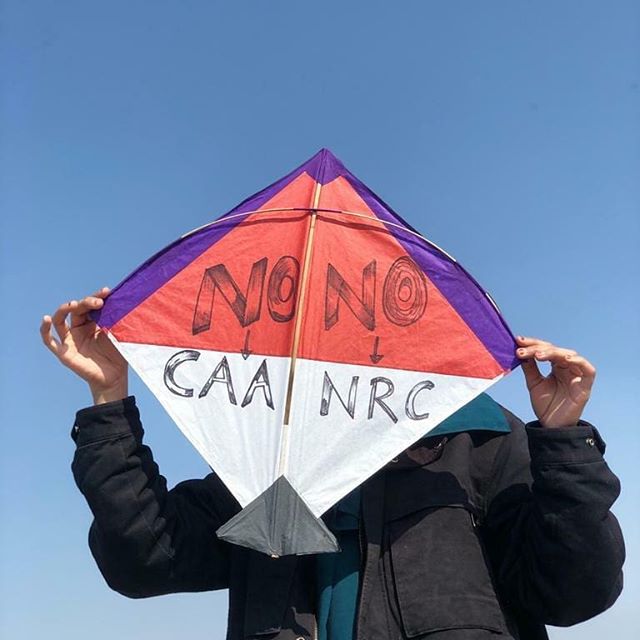With the beginning of a new year, India, a culturally diverse country which is highly dependent on its agricultural sectors to maintain its economy, celebrated a host of auspicious harvest festivals in order to express their gratitude to nature and its produce, which has been a key provider for food and livelihoods for many. Festivals like Lohri, Makar Sankranti, Pongal have unique rites and rituals that are performed by various communities in different parts of the country. They might also have certain religious connotations. However, with time and acculturation, people from different faiths and ethnicities have interacted and exchanged their festivities and celebrations. This year, January, 2020 – the first month of harvest celebration – witnessed a further amalgamation of festivities and the socio-political unrest happening in different parts of the country. This intermingling resulted in unorthodox and inventive ways of expressing resistance against the Islamophobic policies like CAA, NRC and NPR that have been advocated by the ruling BJP government in India.
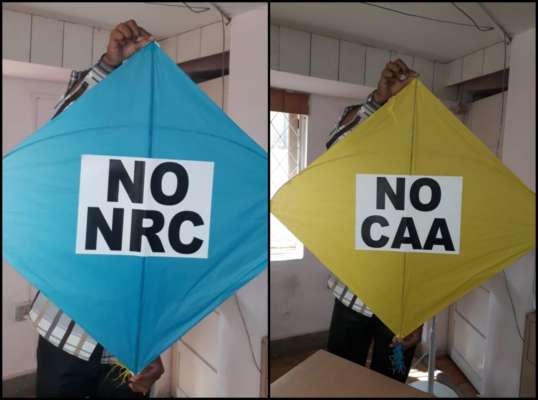
Protests In Festivities
In the North Eastern part of the country, which stood witness to the first organised protests against the unconstitutional Citizenship Amendment Act and the consequent violence, internet ban and curfews, various organisations in the state of Assam such as Asom Jatiyatabadi Yuba Chhatra Parishad, All Assam Students’ Union (AASU) and the Cotton University Students’ Union had appealed to the people to burn copies of the CAA in the Bhogali or Magh Bihu bonfires, in order to display their opposition to the Act – whose implementation risks the indigenous population, their lands and their constitutional rights. Further, to proclaim their resistance, people in Assam have built belaghor (a temporary hay-bamboo structure) in the shape of the map of the state of Assam with anti-CAA messages written on them in Assamese language.
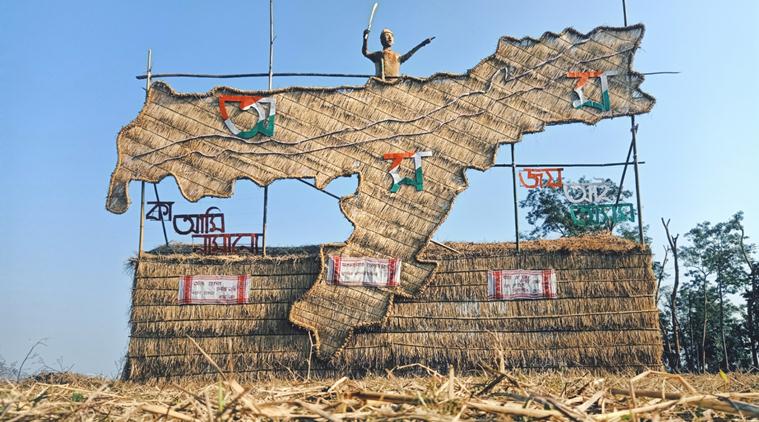
The agenda of the North East population to resist CAA is different than the Hindu-Muslim binary that dominates the protest discourse in mainland India. This multiplicity of rationales for resistances that vary from one part of the country to another indicate that the trio of CAA-NRC-NPR have multiple meanings with regards to the socio-political contexts, and that each of them signify a ‘unity in diversity’ of resistances, all of which attempt at restoring the constitutional values of a democracy.

to proclaim their resistance, people in Assam have built belaghor (a temporary hay-bamboo structure) in the shape of the map of the state of Assam with anti-CAA messages written on them in Assamese language.
On Tuesday the 14th of December, on the occasion of Makar Sankranti, students of Gujarat Vidyapith, in Ahmedabad organised a protest against the Citizenship Amendment Act (CAA) and the National Register of Citizens (NRC) by flying kites that were inscribed with anti-CAA messages on them. In Gujarat, this harvest festival is celebrated with the traditional Kite Festival called Uttarayan, where colourful kites fly with the assistance of the cool winter breeze of January. However, the skies above Gujarat Vidyapith were filled with colours of resistance and solidarity. This protest however, was breached by the state police as they entered the University campus, without any permission and tried to intimidate the students with their unsolicited presence. Hyderabad skies too were reported to have similar instances of flying kites with anti-CAA messages on the occasion of Sankranti.
Also read: Why Are Feminists Opposing The Citizenship Amendment Act?
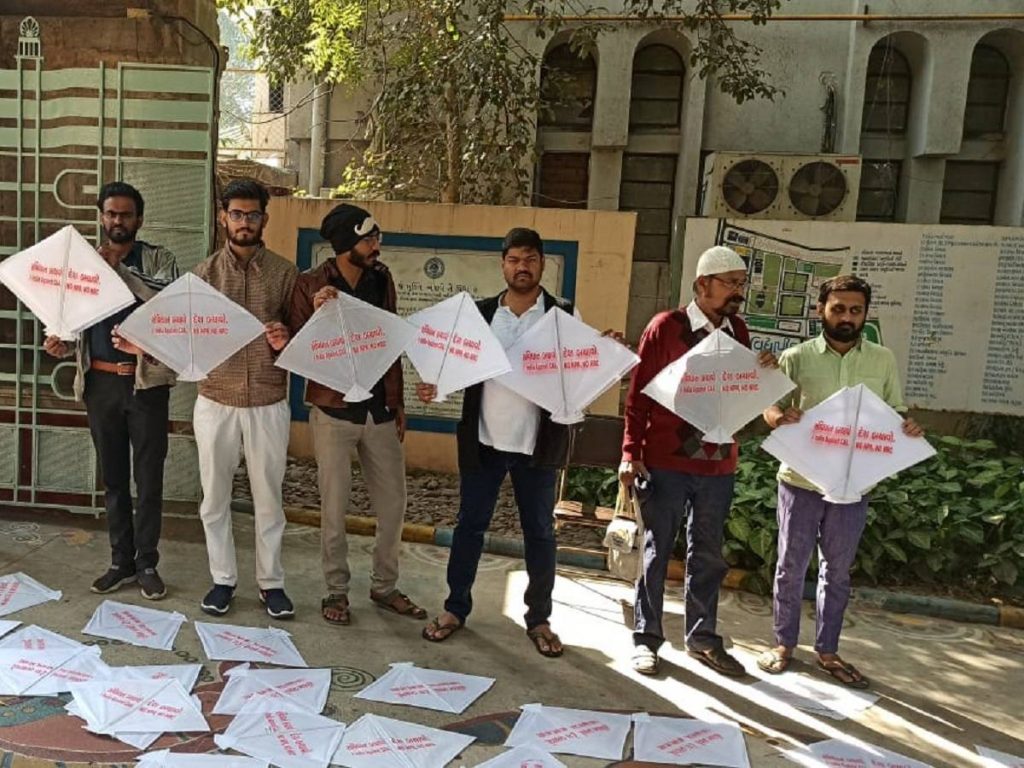
With the commencement of the harvest festival of Tamil Nadu, Pongal on Wednesday, the 15th of January was observed by drawing Kolams (pious motifs drawn with rice powder) that expressed dissent. This is not the first time that people used unconventional strategies to resist against the government. On Sunday the 29th of December, 2019, seven people from Chennai were arrested on grounds of drawing Kolams with “No to NRC, No to CAA” on the pavements of a local residential street. This was done in response to the discriminatory Citizenship Amendment Act that sparked multiple protests across the country, from the North Eastern part of India to the Muslim Universities in the Northern part of the country.
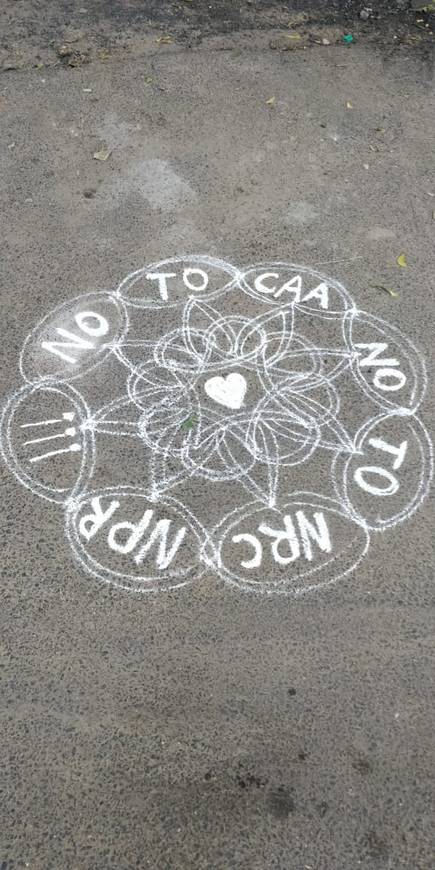
However, most of these protests received reckless police brutality and state sponsored violence in the form of arrests, detentions, imposition of Section 144 and internet shutdowns. Hence, to avoid such extremities, people in solidarity with the resistance against the “Bermuda Triangle” of CAA-NRC-NPR, started innovating their acts of protest. However, they still had to face the same fate of police violence and harassment.
It is a way of reminding ourselves, of the political crisis that we all are facing as citizens of a country, whose values of difference and diversity with respect to religion, ethnicity, caste and gender are at stake.
Festivities In Protests
In Shaheen Bagh, where Muslim women from across Delhi have come together to have a sit-in demonstration from the last one month, have turned their site of protest into a site for secularism where they organised for namaaz, cooked kadha prasad when the Sikh delegates joined the protests, recited holy Hindu, Muslim, Sikh and Christian recitations in “Maha-Path” and celebrated Lohri with all the protesters who joined them on 13th of January. In contrast to earlier instances, here the site of protest was co-opted as a site for communal solidarity through festivities.

Resistance Continues To Live
In India, cultural and ethnic festivities are often kept guarded from the realm of mainstream politics. However, with the unprecedented momentum that protesters have gained, they are not ready to lose its impact and they wish to sustain it till the discriminatory legislation has been repelled. Hence, the celebrations for these harvest festivals are tinted with colours and customs of resistance.
Also read: Park Circus In Kolkata Stands Against The Citizenship Amendment Act
It is a way of reminding ourselves, of the political crisis that we all are facing as citizens of a country, whose values of difference and diversity with respect to religion, ethnicity, caste and gender are at stake. In its broader context, such political statements through festivities also symbolise the cultivation of a responsible citizenry which stands beside one another to protect the human and constitutional rights of the marginalised, thereby harvesting a revolution against the oppressive BJP government.
Featured Image Source: Insgami
About the author(s)
Pragya is a Master's Graduate in Sociology from Jawaharlal Nehru University. She works as the content editor at Feminism In India. She is also a ramen enthusiast, a hummus mother, a postcard hoarder and a wannabe cat lady. She still prefers writing on her notebooks, rather than on her laptop, but her job demands her to do just the opposite. Her favourite season is spring, and her alter ego is that of Mrs. Dalloway who said, "She would buy the flowers herself", in case no man ever buys her any!
